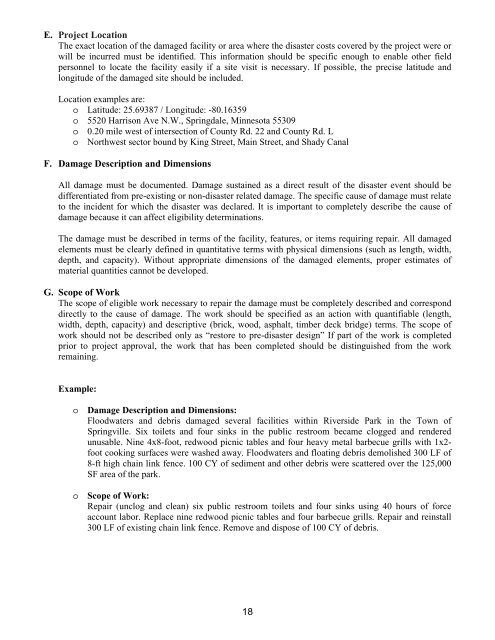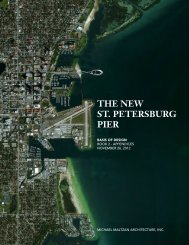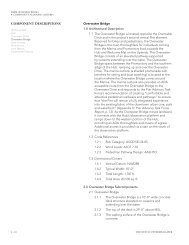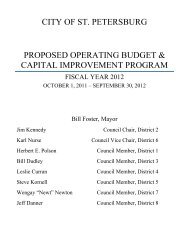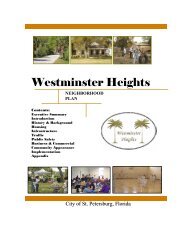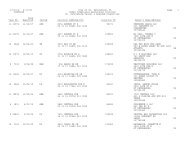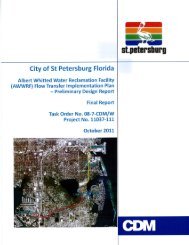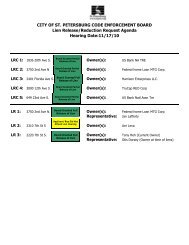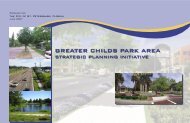Disaster Cost Reimbursement Manual City of St. Petersburg
Disaster Cost Reimbursement Manual City of St. Petersburg
Disaster Cost Reimbursement Manual City of St. Petersburg
You also want an ePaper? Increase the reach of your titles
YUMPU automatically turns print PDFs into web optimized ePapers that Google loves.
E. Project Location<br />
The exact location <strong>of</strong> the damaged facility or area where the disaster costs covered by the project were or<br />
will be incurred must be identified. This information should be specific enough to enable other field<br />
personnel to locate the facility easily if a site visit is necessary. If possible, the precise latitude and<br />
longitude <strong>of</strong> the damaged site should be included.<br />
Location examples are:<br />
o Latitude: 25.69387 / Longitude: -80.16359<br />
o 5520 Harrison Ave N.W., Springdale, Minnesota 55309<br />
o 0.20 mile west <strong>of</strong> intersection <strong>of</strong> County Rd. 22 and County Rd. L<br />
o Northwest sector bound by King <strong>St</strong>reet, Main <strong>St</strong>reet, and Shady Canal<br />
F. Damage Description and Dimensions<br />
All damage must be documented. Damage sustained as a direct result <strong>of</strong> the disaster event should be<br />
differentiated from pre-existing or non-disaster related damage. The specific cause <strong>of</strong> damage must relate<br />
to the incident for which the disaster was declared. It is important to completely describe the cause <strong>of</strong><br />
damage because it can affect eligibility determinations.<br />
The damage must be described in terms <strong>of</strong> the facility, features, or items requiring repair. All damaged<br />
elements must be clearly defined in quantitative terms with physical dimensions (such as length, width,<br />
depth, and capacity). Without appropriate dimensions <strong>of</strong> the damaged elements, proper estimates <strong>of</strong><br />
material quantities cannot be developed.<br />
G. Scope <strong>of</strong> Work<br />
The scope <strong>of</strong> eligible work necessary to repair the damage must be completely described and correspond<br />
directly to the cause <strong>of</strong> damage. The work should be specified as an action with quantifiable (length,<br />
width, depth, capacity) and descriptive (brick, wood, asphalt, timber deck bridge) terms. The scope <strong>of</strong><br />
work should not be described only as “restore to pre-disaster design” If part <strong>of</strong> the work is completed<br />
prior to project approval, the work that has been completed should be distinguished from the work<br />
remaining.<br />
Example:<br />
o Damage Description and Dimensions:<br />
Floodwaters and debris damaged several facilities within Riverside Park in the Town <strong>of</strong><br />
Springville. Six toilets and four sinks in the public restroom became clogged and rendered<br />
unusable. Nine 4x8-foot, redwood picnic tables and four heavy metal barbecue grills with 1x2-<br />
foot cooking surfaces were washed away. Floodwaters and floating debris demolished 300 LF <strong>of</strong><br />
8-ft high chain link fence. 100 CY <strong>of</strong> sediment and other debris were scattered over the 125,000<br />
SF area <strong>of</strong> the park.<br />
o Scope <strong>of</strong> Work:<br />
Repair (unclog and clean) six public restroom toilets and four sinks using 40 hours <strong>of</strong> force<br />
account labor. Replace nine redwood picnic tables and four barbecue grills. Repair and reinstall<br />
300 LF <strong>of</strong> existing chain link fence. Remove and dispose <strong>of</strong> 100 CY <strong>of</strong> debris.<br />
18


